#st jean d'acre
Text
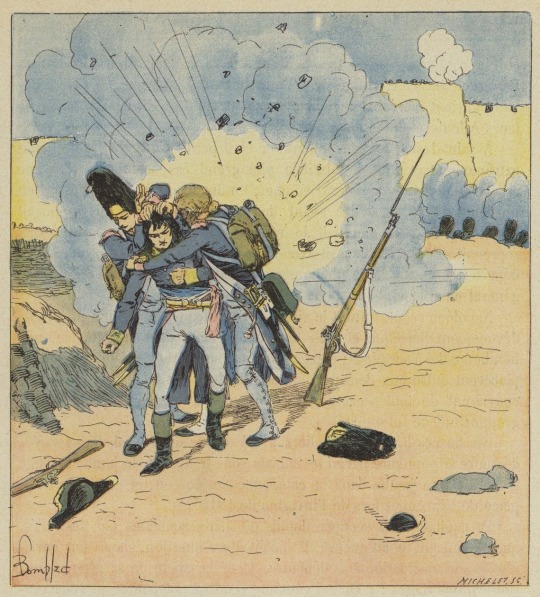
At St Jean d'Acre, the grenadiers Daumesnil and Souchon cover Bonaparte with their bodies to protect him from the shrapnel of a bomb blast.
by Louis Charles Bombled
#napoléon#napoleon#bonaparte#napoleon bonaparte#napoléon bonaparte#acre#art#siege of acre#louis charles bombled#pierre daumesnil#claude souchon de chanron#grenadier#grenadiers#french revolutionary wars#history#france#french#europe#european#middle east#saint jean d'acre#st jean d'acre#ottoman empire#ottoman#french republic#siege
134 notes
·
View notes
Text

HMS St Jean d'Acre off the Coast of Torbay, by William Adolphus Knell (1805-1875)
87 notes
·
View notes
Text
Here's some Templars whose research distracted me very well from the happenings in Paris and the fact I'm ordering food via phone to go out as little as possible. Okay. Here's what I found:


Transcript of the first and second page:
André de Montbard
was born on November 5th 1097. All we know is that he had richt even noble parents and that he was the fifth Grand Master and founder of the Templars.
Bertrand de Blanchefort
was the sixth Grand Master and was born sometime in 1109. He fostered the Templars as guardians of travelling Christians rather than brutes despite their weaponry. For three years he was a prisoner of was and went on one single expedition, declining a second.
Philip of Nablus, also: of Milly
actually a Jerusalem-born man in 1120. Wasn't too fond of being Grand Master yet submitted to Almaric pressuring him. He became seventh Grand Master and resigned in 1171.
Ode de St. Amand
was the eigth Grand Master born in 1110. He was captured by Saladin in the battle of Morj Ayyun, to the dismay of his fellows since he was described as a headstrong guy, leading in both praise and resentment and being a valuable member.
Arnold of Torroja
born in wherever and whenever, he was the ninth Grand Master at the ripe age of 70. He worked on Hispaniola in the Reconquista. His capability in negotiating even with Saladin made him an important GM, so important that his tomb was only discovered in 2018, very well hidden from others.
Gerard de Rideford
hid his birth year but died in 1189. Used to be the 10th Grand Master of the Templars. He used king Henry II's money to bring more troops to Jerusalme. Apparently he was pretty beloved, as Saladin offered his life for a peaceful surrender, which succeeded and he was released to Tortosa.

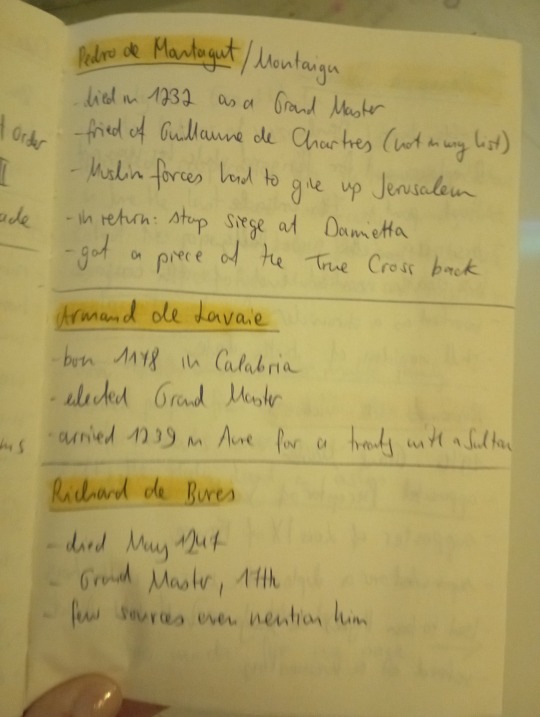
Transcript of the third and fourth page:
Robert de Sablé
was born a lord of Sablé in 1150. Not only was he the eleventh Grand Master but also member of the Valiant Order. Helped Henry Hunior revolt against his daddy Henry II and also convinced Islamic troops to retreat in the third crusade.
Gilbert Erail (or Horal)
born whenever, died in 1200. He was the twelfth Grand Master and aspired to wage peace, not war, in between Christians and Muslims.
Philippe de Plessis
castle-forn or rather fortress-born in France in 1165. Was the thirteenth Grand Master of the Templars and had semi-good relationships to the Hospitallers (kinda like the Templars but evangelican Maltesers). Suggested a peace treaty with Malek Adhel.
Pedro de Montagut (or Montaigu)
died in 1232 while still being a Grand Master and ways a friend of Guillaume de Chartes, whoever that was. Made a deal with the Muslims: they gave up Jerusalem while the Templars stopped the siege of Damietta. Most importantly he got a piece of the True cross, I wonder if that's still somewhere?
Armand de Lavaie
he was born in 1178 in Calabria and elected Grand Master. Death is really unclear, some say he died in battle, others say he survived capture. In 1239 he arrived in Acre for a treaty with a sultan.
Richard de Bures
is somewhat of a ghost since all we know is he died in May 1247 and was the seventeenth Grand Master.

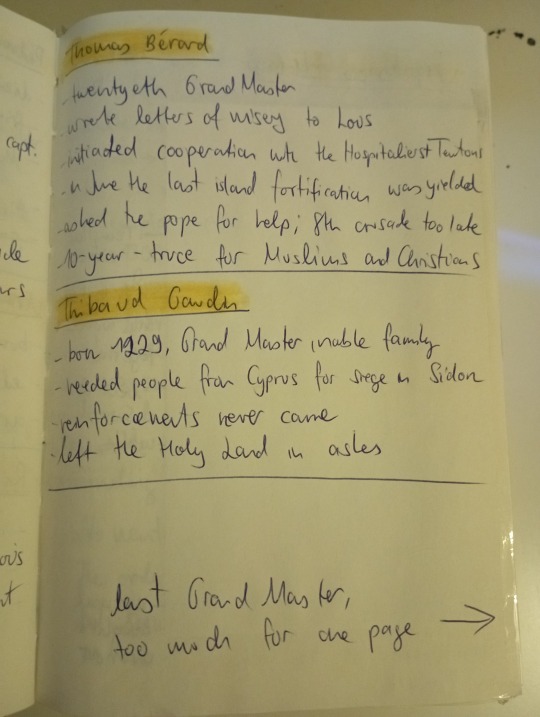
Transcript of the fifth and sixth page:
Guillaume de Sonnac
a noble-born Frenchman whose birth date is unclear. Took part in the successful 7th crusade. He worked as a chronicler for the Templars, lots of information we know on them cites him as source. He replaces Périgord while this guy was captured, and his death was the end of the 17th crusade.
Renaud de Vichiers
was the 19th Grand Master of the Templars and the preceptor of Saint Jean-d'Acre. He was having issues with Hugues de Joug and had to throw him out of the order to stop their fight. Lois IX of France was a supporter and financer of Renaud, but he again fought with him and parted int he end over a diplomatic mission. He retired in a monastery, and if not alone, he argues to this day.
Thomas Bérard
wrote letters of misery to king Lois despite being twentieth Grand Master and somewhat respectable. He initiated a cooperation with the Hospitaliers Teutons and yielded the last island's fortification in June. Asking the Pope for help he waged the 8th crusade which became the last since Lois died. His most significant win: a 10-year-truce for Muslims and Christians.
Thibaud Gaudin
another man with rich parents boen in 1229 was the 22nd Grand Master of the Knights Templars. Demanding people from Cyprus for a siege in Sidon wasn't successful since the reinforcements never came, so he left the Holy Land in ashes.
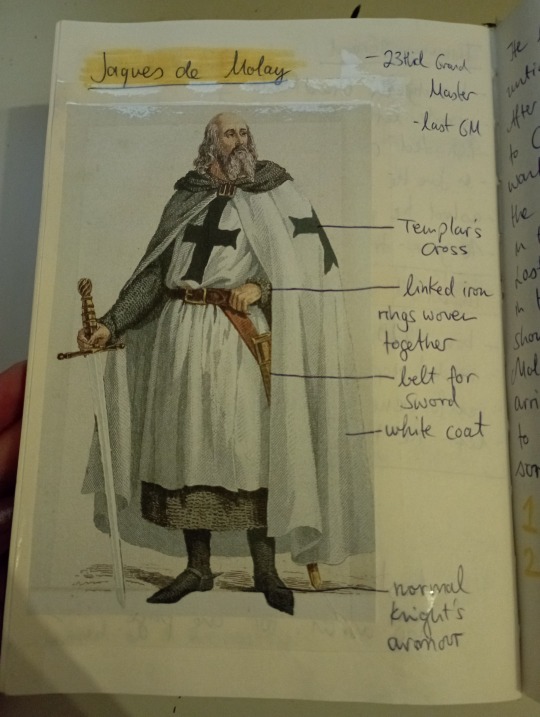
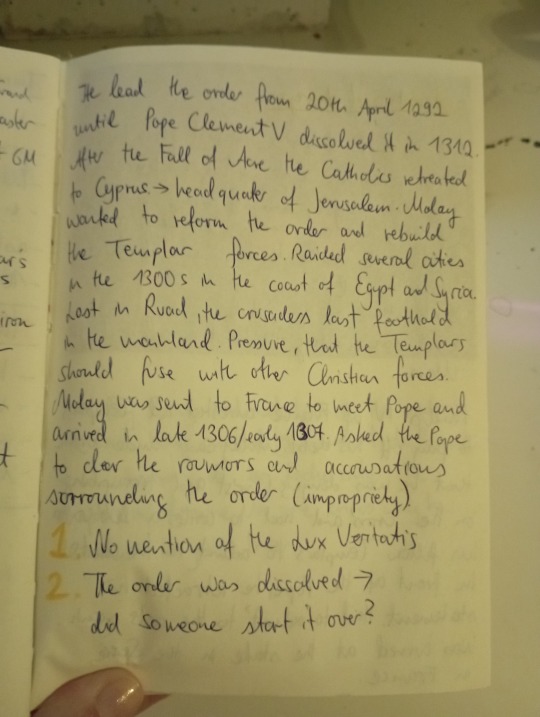
That's Jaques de Molay, the 23rd and last of the Knights Templar's Grand Masters. I found a painting depicting him and it showed me how Templars looked like, from an ancient point of view, not one in Hollywood. Templars were called Knights Templars and would own and wear a normal knight's armour during the day. Above that, they had a white cloak with a black Christian cross on it, and a leather belt in which they could carry their swords in.
Molay lead the order from the 20th April of 1292 until Pope Clement V was having none of it and dissolved the order in 1312. After the fall of Acre the Catholics retreated to Cyprus, the headquater of Jerusalem. He wanted to obviously keep the order and tried to rebuild the Templars, raiding several cities in the 1300s at the coast of Egypt and Syria (not very Christian huh?). They lost in Ruad and had to retreat to the shore, always feeling the pressure to collaborate with other Christian forces. Molay was sent to France to meet up with the Pope and arrived in 1306 or 1307. He even asked the Pope to wipe the name of the Knights templars clear and adress the rumours and accousations.
What I gathered from all of this?
There is no mention of the Lux Veritatis and the order was dissolved and never officially continued. Now, theory: what if someone started over and renamed the club into the LV? Could that be possible? I mean, there's plenty of ties to France...
#tomb raider angel of darkness#traod#classic tr#tomb raider#angel of darkness#journal#aod#lara craft#tomb raider series
2 notes
·
View notes
Photo
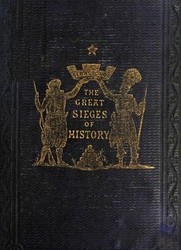
The Great Sieges of History by William Robson
https://www.gutenberg.org/ebooks/59093
AuthorRobson, William, 1785-1863
IllustratorGilbert, John, 1817-1897
TitleThe Great Sieges of History
ContentsBactra -- Aï -- Thebes, in Bœotia -- Thebes, Palestine -- Troy -- Jerusalem -- Samaria -- Rome -- Nineveh -- Azoth -- Tyre -- Sardis -- Babylon -- Corioli -- Veii -- Falerii -- Platææ -- Byblos -- Athens -- Syracuse -- Agrigentum -- Byzantium -- Rhodes -- Lyons -- Gaza -- Persepolis -- Lacedæmon -- Argos -- Messina -- Corinth -- Tarentum -- Tunis -- Carthagena -- Utica -- Abydos -- Cremona -- Carthage -- Toulouse -- Sinope -- Paris -- Rimini -- Marseilles -- Alexandria -- Palmyra -- Milan -- Tournai -- Orleans -- Pavia -- Ravenna -- Antioch -- Naples -- Edessa -- Kaibar -- Weinsberg -- Damascus -- Lisbon -- St. Jean d'Acre -- Dover -- Bagdad -- Cassel -- Romorantin -- La Rochelle -- Cassovia -- Troyes -- Belgrade -- Castillon -- Liége -- Beauvais -- Grenada -- Vienna -- Algiers -- Valenciennes -- Leyden -- Livron -- Cahors -- Mæestricht -- Antwerp -- Malta -- Vachtendonck -- Ostend -- Bergen-op-Zoom -- Magdeburg -- Turin -- Arras -- Verchères -- Stralsund -- Frederikshall -- Schweidnitz -- Ismaïl -- Bommel -- Barcelona -- Gibraltar -- Seringapatam -- Saragossa -- Badajos -- Constantinople -- Ciudad Rodrigo -- Castle of Burgos -- St. Sebastian -- Sebastopol.
LanguageEnglish
LoC ClassD: History: General and Eastern Hemisphere
Subject: Sieges
CategoryText
EBook-No.59093
Release DateMar 19, 2019
Copyright StatusPublic domain in the USA.
2 notes
·
View notes
Text

HMS St Jean d'Acre off the Coast of Torbay, by William Knell (1805-1875)
93 notes
·
View notes
Text
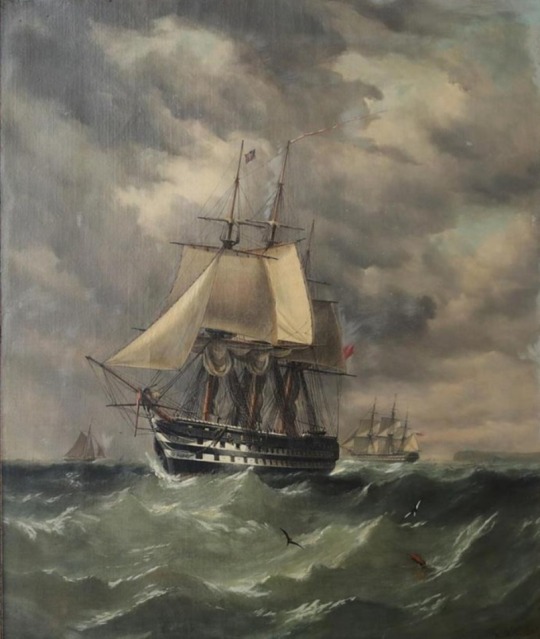
HMS St Jean d'Acre off the Coast of Torbay, by William Adolphus Knell (1805-1875)
76 notes
·
View notes
Text

Man Overboard: Rescue Launch from HMS St Jean d'Acre, by Sir Oswald Walters Brierly, after 1854
An interpretation of an incident in 1854 when the artist went to the Baltic as a guest of Captain Harry Keppel in HMS St Jean d' Acre during the Crimean War of 1854-56. The ship, a first-rate three-decker with 101 guns, is portrayed hove-to, flying the Church pendant as a signal for 'man overboard'.
111 notes
·
View notes
Text

Man Overboard: Rescue Launch from HMS St. Jean d'Acre, by Oswald Walters Brierly (1817–1894)
Maybe she's a man-eater. Even though we like to use this term today for women who have quite a few sexual partners. To say it nicely. Does the term actually have a nautical background. It was used to name ships that truly hated their crews. What in the form of, storms, equipment failures, a fall from the rigging, death, injuries, or just bad luck. And on every voyage and almost every day.
Such wooden ladies, of course, had their reputation gone and this spread quickly among sailors, especially in taverns and boarding houses. And that led that the captain had great problems finding a crew, because who likes to sail on a considered evil ship.
46 notes
·
View notes
Link
AuthorRobson, William, 1785-1863
IllustratorGilbert, John, 1817-1897
TitleThe Great Sieges of History
ContentsBactra -- Aï -- Thebes, in Bœotia -- Thebes, Palestine -- Troy -- Jerusalem -- Samaria -- Rome -- Nineveh -- Azoth -- Tyre -- Sardis -- Babylon -- Corioli -- Veii -- Falerii -- Platææ -- Byblos -- Athens -- Syracuse -- Agrigentum -- Byzantium -- Rhodes -- Lyons -- Gaza -- Persepolis -- Lacedæmon -- Argos -- Messina -- Corinth -- Tarentum -- Tunis -- Carthagena -- Utica -- Abydos -- Cremona -- Carthage -- Toulouse -- Sinope -- Paris -- Rimini -- Marseilles -- Alexandria -- Palmyra -- Milan -- Tournai -- Orleans -- Pavia -- Ravenna -- Antioch -- Naples -- Edessa -- Kaibar -- Weinsberg -- Damascus -- Lisbon -- St. Jean d'Acre -- Dover -- Bagdad -- Cassel -- Romorantin -- La Rochelle -- Cassovia -- Troyes -- Belgrade -- Castillon -- Liége -- Beauvais -- Grenada -- Vienna -- Algiers -- Valenciennes -- Leyden -- Livron -- Cahors -- Mæestricht -- Antwerp -- Malta -- Vachtendonck -- Ostend -- Bergen-op-Zoom -- Magdeburg -- Turin -- Arras -- Verchères -- Stralsund -- Frederikshall -- Schweidnitz -- Ismaïl -- Bommel -- Barcelona -- Gibraltar -- Seringapatam -- Saragossa -- Badajos -- Constantinople -- Ciudad Rodrigo -- Castle of Burgos -- St. Sebastian -- Sebastopol.
LanguageEnglish
LoC ClassD: History: General and Eastern Hemisphere
SubjectSieges
CategoryText
EBook-No.59093
Release DateMar 19, 2019
Copyright StatusPublic domain in the USA.
0 notes